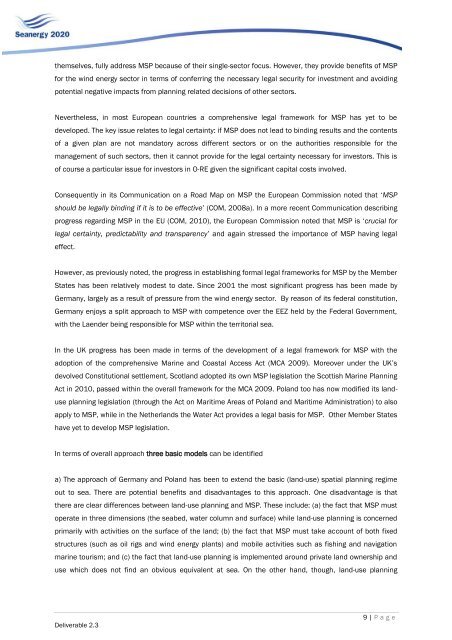Comparative analysis of Maritime Spatial Planning ... - Seanergy 2020
Comparative analysis of Maritime Spatial Planning ... - Seanergy 2020
Comparative analysis of Maritime Spatial Planning ... - Seanergy 2020
Create successful ePaper yourself
Turn your PDF publications into a flip-book with our unique Google optimized e-Paper software.
themselves, fully address MSP because <strong>of</strong> their single-sector focus. However, they provide benefits <strong>of</strong> MSPfor the wind energy sector in terms <strong>of</strong> conferring the necessary legal security for investment and avoidingpotential negative impacts from planning related decisions <strong>of</strong> other sectors.Nevertheless, in most European countries a comprehensive legal framework for MSP has yet to bedeveloped. The key issue relates to legal certainty: if MSP does not lead to binding results and the contents<strong>of</strong> a given plan are not mandatory across different sectors or on the authorities responsible for themanagement <strong>of</strong> such sectors, then it cannot provide for the legal certainty necessary for investors. This is<strong>of</strong> course a particular issue for investors in O-RE given the significant capital costs involved.Consequently in its Communication on a Road Map on MSP the European Commission noted that „MSPshould be legally binding if it is to be effective‟ (COM, 2008a). In a more recent Communication describingprogress regarding MSP in the EU (COM, 2010), the European Commission noted that MSP is „crucial forlegal certainty, predictability and transparency‟ and again stressed the importance <strong>of</strong> MSP having legaleffect.However, as previously noted, the progress in establishing formal legal frameworks for MSP by the MemberStates has been relatively modest to date. Since 2001 the most significant progress has been made byGermany, largely as a result <strong>of</strong> pressure from the wind energy sector. By reason <strong>of</strong> its federal constitution,Germany enjoys a split approach to MSP with competence over the EEZ held by the Federal Government,with the Laender being responsible for MSP within the territorial sea.In the UK progress has been made in terms <strong>of</strong> the development <strong>of</strong> a legal framework for MSP with theadoption <strong>of</strong> the comprehensive Marine and Coastal Access Act (MCA 2009). Moreover under the UK‟sdevolved Constitutional settlement, Scotland adopted its own MSP legislation the Scottish Marine <strong>Planning</strong>Act in 2010, passed within the overall framework for the MCA 2009. Poland too has now modified its landuseplanning legislation (through the Act on <strong>Maritime</strong> Areas <strong>of</strong> Poland and <strong>Maritime</strong> Administration) to alsoapply to MSP, while in the Netherlands the Water Act provides a legal basis for MSP. Other Member Stateshave yet to develop MSP legislation.In terms <strong>of</strong> overall approach three basic models can be identifieda) The approach <strong>of</strong> Germany and Poland has been to extend the basic (land-use) spatial planning regimeout to sea. There are potential benefits and disadvantages to this approach. One disadvantage is thatthere are clear differences between land-use planning and MSP. These include: (a) the fact that MSP mustoperate in three dimensions (the seabed, water column and surface) while land-use planning is concernedprimarily with activities on the surface <strong>of</strong> the land; (b) the fact that MSP must take account <strong>of</strong> both fixedstructures (such as oil rigs and wind energy plants) and mobile activities such as fishing and navigationmarine tourism; and (c) the fact that land-use planning is implemented around private land ownership anduse which does not find an obvious equivalent at sea. On the other hand, though, land-use planningDeliverable 2.39 | P a g e






